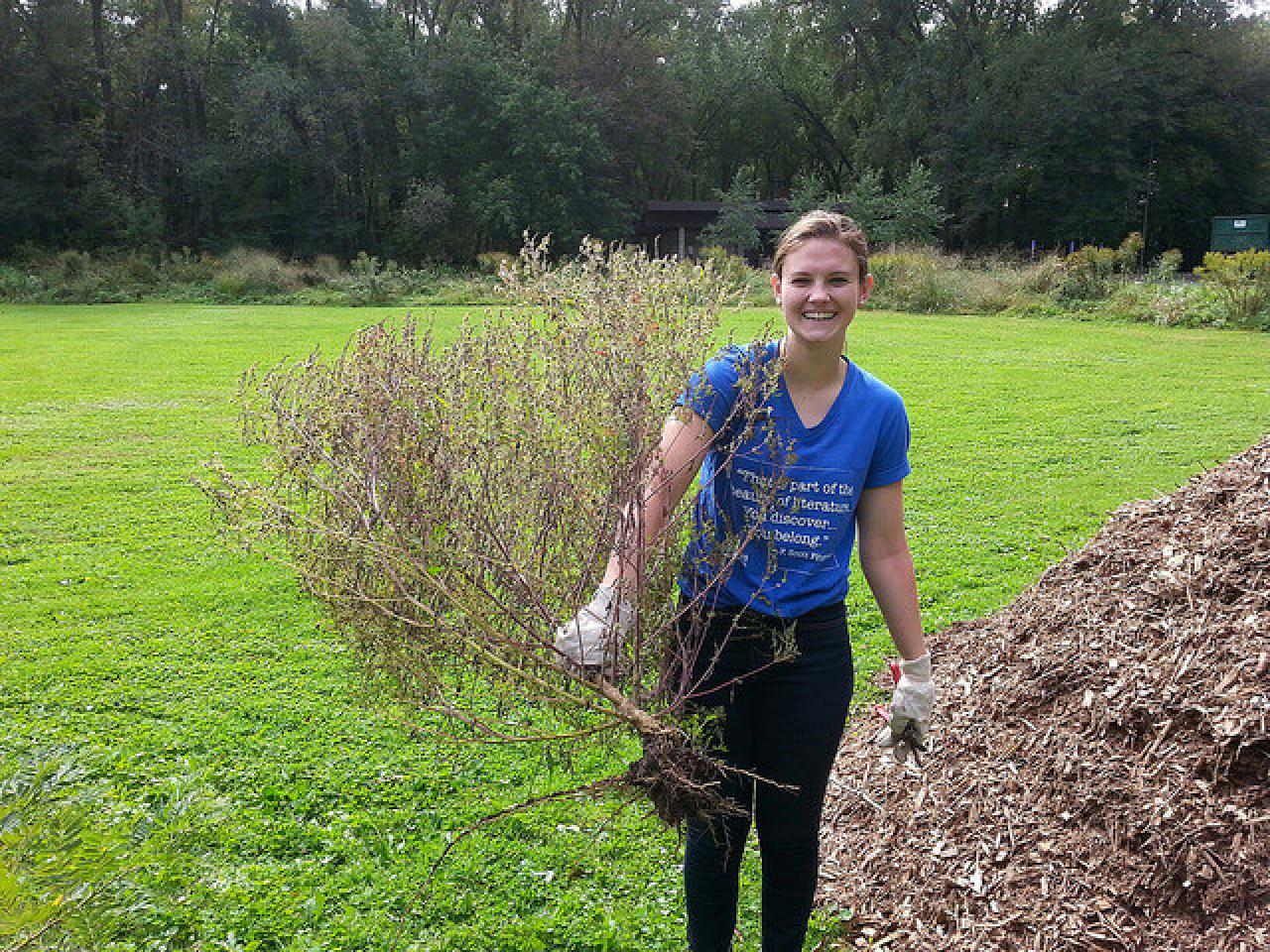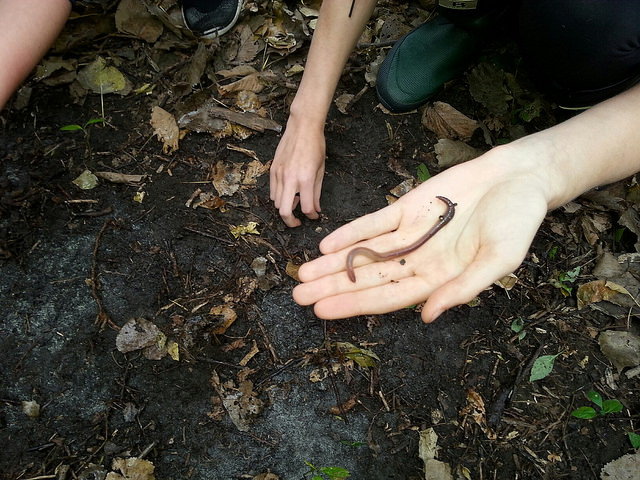Out of the classroom and into the weeds, woods ... and worms?

by Clare Tipler
We donned our rain jackets and boots, as there had been a rainstorm the night before, and jumped on the bus. On the way to our destination, our teacher Mr. Heckman briefed us on where we were going: Crosby Park along the St. Paul riverfront.
Upon our arrival, we got a quick introduction to Friends of the Mississippi River and were told that we were there to pull invasive plant species as part of a larger habitat restoration project. The bus had dropped us off right at the patch we were to work in. It was huge, a 40 by 10-foot plot densely packed with thistle, ragweed and grass. We were told to pull anything that wasn’t woody, anything without a trunk. With gardening gloves on and shears in hand, we got straight to work.
With 18 students and a little over an hour, it’s amazing what progress can be made.
Despite needing to take a break to discuss and puzzle over encounters with worms, slugs, snakes, mice, a golf club (?!) and some socks, we were able to almost completely clear the area of invasives. Though this may seem like a simple service project (and like something your grandma might ask you to do in her rose garden), I realized there’s more than one way to learn about science. This wasn’t a classroom lecture by any stretch of the imagination, and yet I learned just as much if not more from this experience.
It was awesome to be surrounded by FMR and St. Paul Parks & Recreation staff because whenever I had a question, I'd just blurt it out and get an immediate answer. When I was curious about how all these invasive species got here, the closest staff person immediately explained that animals ate the seeds then disposed of them through their waste in a different location. Winds also carry them, so seeds can spread and thrive pretty quickly.
This version of science learning was much more fun than being in the classroom. And while it had all seemed pretty daunting when we'd first gotten off the bus, I wasn't exactly eager to get back on. Luckily, we had more FMR field trips planned.
Hands-on learning
At St. Paul Academy and Summit School, I'm part of an amazing environmental science class taught by Mr. Ned Heckman. Aimed at juniors and seniors who loved sophomore year’s biology class, but want to go deeper into environmental studies than a general biology course could, the class takes a hands-on, service-learning approach. This includes field trips, service trips, group labs, and partner projects, all in addition to classroom learning. We partnered with Friends of the Mississippi River for three field trips throughout the course of the semester.
For me, the FMR field trips were the highlight of the course.
Spray painting for a good cause
Our class’s second trip with FMR was a stenciling project in the few blocks surrounding our school. We were to stencil ‘Keep 'em Clean, Drains to River’ near street sewer drains to inform the community that they led directly to the Mississippi River.
After putting on our incredibly fashionable bright orange safety vests, we set off with all our supplies including a map of the area, a handful of informational flyers, and white spray paint. I personally hung more than 30 flyers while my classmates stenciled the message on more than a dozen sewers near our school.
This service trip hopefully informed our neighbors about something new, but it also made me realize that environmental efforts are not individual efforts: it’s about getting the information out, getting help, and getting work done. That’s exactly what we did while stenciling.
What worms can teach us
For our third and final trip we headed back to Crosby Park; but this time, it was to collect data for further experiments conducted in the classroom lab. Here, we split into three groups: a water group, a soil group, and a biodiversity group.
The water group took samples from Crosby Lake and the Mississippi River to test later. Though this was the quickest and easiest collection, we walked a long way to get to the water sources and had time to appreciate this amazing area in which we live.
The soil group took soil samples from three different habitats — the upper forest, prairie and floodplain — to test later in our lab. This group also documented what species lived in the area around where they collected their soil, paying special attention to invasives.
The biodiversity group worked to collect data on worm populations also in the upper forest, prairie and floodplain ecosystem. To do this, they poured water with mustard powder over an area and counted how many worms surfaced. The mustard powder irritates the worms’ skin and makes them surface and thus, able to be counted (and counting means picking up ... so that was messy).
Once in our lab back at school, these groups split even further and performed various tests on what was collected or observed.
This trip allowed us to apply the science we had been learning about to a real-life situation, and provide valuable information to FMR and the city of St. Paul. This in itself made it significant, but we also learned how all of the indicators we tested impact the health of an area. Soil nitrates in healthy levels foster healthy plant growth, soil pH is best between 6.0 and 7.5 for a balance of nutrients, worms are actually invasive species that limit the growth of native plants and high nitrate levels in water are caused by waste and farm runoff.
Connecting to the river, to our community
Going into the class, I didn’t expect to learn as much as I did. Not only did the field trips and service-learning approach increase the variety of what I learned, they taught me a lot beyond the curriculum. Now I know that a group can make a difference in their community and do real work for positive change.
We accomplished a lot by pulling invasive species, stenciling and educating our neighbors about where storm sewers lead, and helping the FMR ecologists assess the health of an important riverfront park. Plus we had fun while doing it — finding random objects while pulling weeds, appreciating our local environment, working in the lab, and spray painting. And I learned that I can learn a lot more than I thought by getting my hands dirty.
Resources for educators
If you're an educator and would like to better connect your class to the river, FMR offers:
• storm drain stenciling outings in St. Paul and North and Northeast Minneapolis
• interactive watershed education presentations in St. Paul and North and Northeast Minneapolis
• and a State of the River Report Teacher's Guide featuring hands-on activities that also meet core standards
For more information, contact FMR Youth Coordinator Kate Clayton, education@fmr.org.
